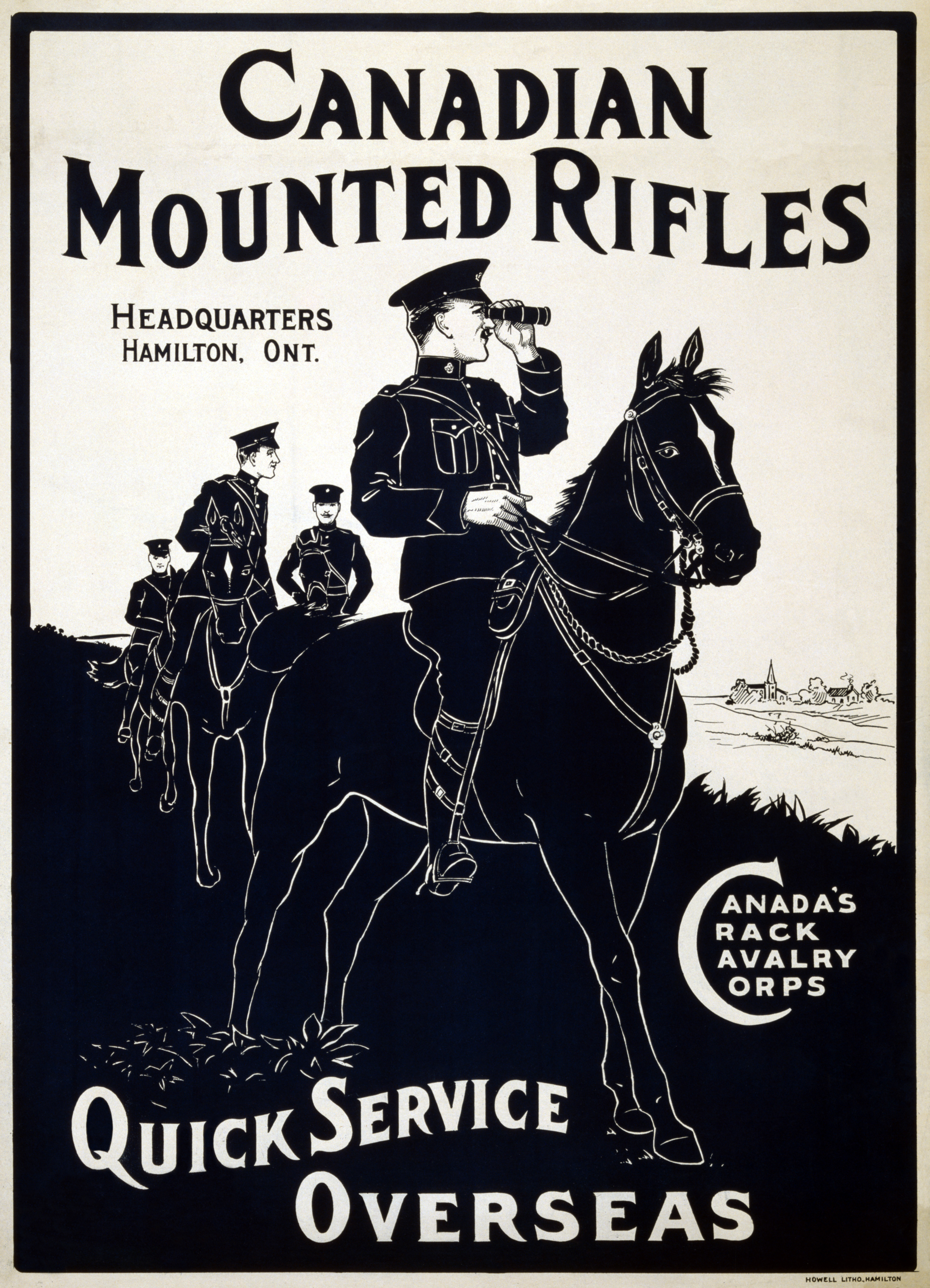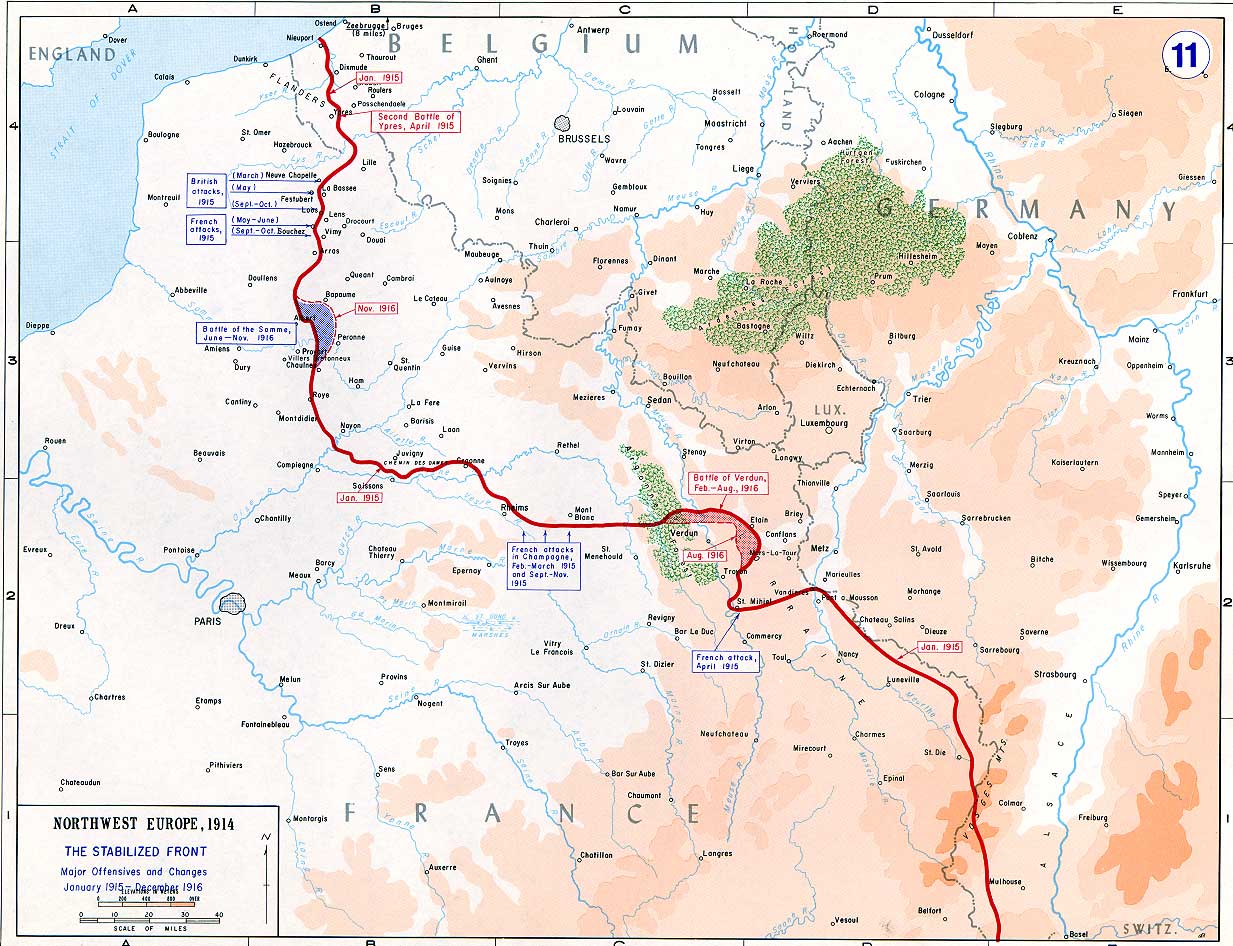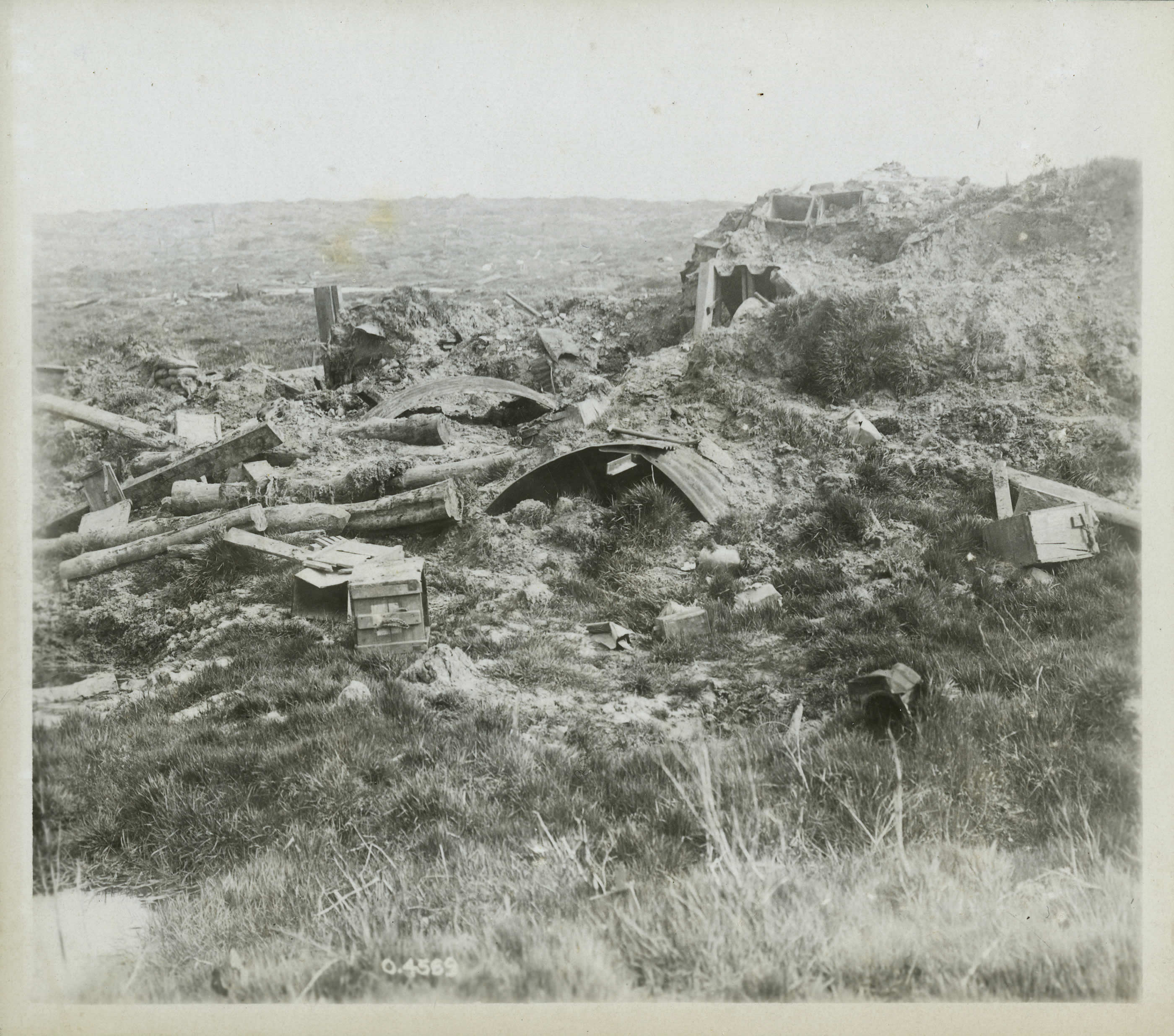|
6th Regiment, Canadian Mounted Rifles
The 6th Regiment, Canadian Mounted Rifles, CEF, was a mounted infantry unit of the Canadian Expeditionary Force in the First World War. History The regiment was formed on March 15, 1915, at Amherst, Nova Scotia . It recruited in Nova Scotia, New Brunswick, and Prince Edward Island. It sailed to England in July, 1915, and after training arrived in France on October 22, 1915. It served in the field as infantry until December, 1915. On January 1, 1916, the six regiments of Canadian Mounted Rifles were converted to infantry and reorganized into the four battalions of the 8th Canadian Infantry Brigade . The personnel of the 6th Regiment were absorbed into the 4th and 5th Battalions, CMR. Perpetuation The 6th Regiment was perpetuated by the King's Canadian Hussars, which was converted to an artillery unit in 1939, and later by the 8th Canadian Hussars (Princess Louise's). Battle Honours * Mount Sorrell * Somme, 1916 * France And Flanders, 1915-16 See Also * List of ... [...More Info...] [...Related Items...] OR: [Wikipedia] [Google] [Baidu] |
Canadian Mounted Rifles
Canadian Mounted Rifles was part of the designation of several mounted infantry units in Canada in the late 19th and early 20th centuries. Units of the Permanent Active Militia Units formed for the Second Boer War Independent squadrons of the Non-Permanent Active Militia Units of the Canadian Expeditionary Force of the First World War See also * List of mounted regiments in the Canadian Expeditionary Force *List of infantry battalions in the Canadian Expeditionary Force *Mounted Infantry * Canadian Militia *History of the Canadian Army *Permanent Active Militia *Non-Permanent Active Militia *Military history of Canada during World War I * Australian Light Horse * Imperial Yeomanry * Otter Commission The Otter Commission, or Otter Committee, was established after the First World War to tackle a problem created by the chaotic mobilization of the Canadian Expeditionary Force. In 1919 units of the CEF, intended as a wartime expeditionary force, re ... Refer ... [...More Info...] [...Related Items...] OR: [Wikipedia] [Google] [Baidu] |
King's Canadian Hussars
The King's Canadian Hussars were a cavalry regiment of the Non-Permanent Active Militia of the Canadian Militia (now the Canadian Army). In August 1939, the regiment was converted to artillery and currently exists today as the 87th Field Battery, RCA. Lineage * Originated on 12 June 1874, in Kentville, Nova Scotia as the King's Canadian Hussars. * Organized on 1 December 1903, as a full regiment. * Reorganized on 1 April 1904, as the 14th King's Canadian Hussars. * Redesignated on 15 March 1920, as The King's (Nova Scotia) Mounted Rifles. * Redesignated on 1 December 1925, as the King's Canadian Hussars. * Amalgamated on 1 December 1936, with C Company of The Colchester and Hants Regiment and B Company of the 6th Machine Gun Battalion, CMGC and Redesignated as the King's Canadian Hussars (Armoured Car). * Converted on 1 August 1939, from Light Armour to Artillery and Formed the 87th Field Battery, RCA and the 88th Field Battery, RCA. Perpetuations The Great War * 6th Regi ... [...More Info...] [...Related Items...] OR: [Wikipedia] [Google] [Baidu] |
Mounted Rifle Regiments Of Canada
Mount is often used as part of the name of specific mountains, e.g. Mount Everest. Mount or Mounts may also refer to: Places * Mount, Cornwall, a village in Warleggan parish, England * Mount, Perranzabuloe, a hamlet in Perranzabuloe parish, Cornwall, England * Mounts, Indiana, a community in Gibson County, Indiana, United States People * Mount (surname) * William L. Mounts (1862–1929), American lawyer and politician Computing and software * Mount (computing), the process of making a file system accessible * Mount (Unix), the utility in Unix-like operating systems which mounts file systems Displays and equipment * Mount, a fixed point for attaching equipment, such as a hardpoint on an airframe * Mounting board, in picture framing * Mount, a hanging scroll for mounting paintings * Mount, to display an item on a heavy backing such as foamcore, e.g.: ** To pin a biological specimen, on a heavy backing in a stretched stable position for ease of dissection or display ** To ... [...More Info...] [...Related Items...] OR: [Wikipedia] [Google] [Baidu] |
List Of Mounted Regiments In The Canadian Expeditionary Force
During the First World War, the Canadian government authorized the formation of several mounted regiments, including cavalry and mounted infantry, to serve in the Canadian Expeditionary Force on the Western Front . Three regiments, the Royal Canadian Dragoons, Lord Strathcona's Horse, and the Fort Garry Horse, served as throughout the war as part of the Canadian Cavalry Brigade, attached to British Army cavalry formations. One regiment, the Canadian Light Horse, served as the Canadian Corps cavalry regiment. Six regiments of mounted rifles served initially at the front as mounted infantry before being converted to infantry battalions. The remaining mounted rifle regiments were raised in Canada but broken up in England to provide reinforcements for other cavalry, mounted infantry and infantry units. The regiments in bold type served in the field. {, class="wikitable sortable" , + Cavalry and mounted rifle units of the Canadian Expeditionary Force , - ! Regiment ! data-sort-t ... [...More Info...] [...Related Items...] OR: [Wikipedia] [Google] [Baidu] |
Western Front (World War I)
The Western Front was one of the main theatres of war during the First World War. Following the outbreak of war in August 1914, the German Army opened the Western Front by invading Luxembourg and Belgium, then gaining military control of important industrial regions in France. The German advance was halted with the Battle of the Marne. Following the Race to the Sea, both sides dug in along a meandering line of fortified trenches, stretching from the North Sea to the Swiss frontier with France, which changed little except during early 1917 and in 1918. Between 1915 and 1917 there were several offensives along this front. The attacks employed massive artillery bombardments and massed infantry advances. Entrenchments, machine gun emplacements, barbed wire and artillery repeatedly inflicted severe casualties during attacks and counter-attacks and no significant advances were made. Among the most costly of these offensives were the Battle of Verdun, in 1916, with a combined 700 ... [...More Info...] [...Related Items...] OR: [Wikipedia] [Google] [Baidu] |
Battle Of The Somme
The Battle of the Somme (French: Bataille de la Somme), also known as the Somme offensive, was a battle of the First World War fought by the armies of the British Empire and French Third Republic against the German Empire. It took place between 1 July and 18 November 1916 on both sides of the upper reaches of the Somme, a river in France. The battle was intended to hasten a victory for the Allies. More than three million men fought in the battle of whom one million were wounded or killed, making it one of the deadliest battles in human history. The French and British had committed themselves to an offensive on the Somme during the Chantilly Conference in December 1915. The Allies agreed upon a strategy of combined offensives against the Central Powers in 1916 by the French, Russian, British and Italian armies, with the Somme offensive as the Franco-British contribution. Initial plans called for the French army to undertake the main part of the Somme offensive, supported ... [...More Info...] [...Related Items...] OR: [Wikipedia] [Google] [Baidu] |
Battle Of Mont Sorrel
The Battle of Mont Sorrel (''Battle of Mount Sorrel'', ''Battle of Hill 62'') was a local operation in World War I by three divisions of the British Second Army and three divisions of the German 4th Army in the Ypres Salient, near Ypres, Belgium, from 2 to 13 June 1916. To divert British resources from the build-up being observed on the Somme, the XIII (Royal Württemberg) Corps and the 117th Infantry Division attacked an arc of high ground defended by the Canadian Corps. The German forces captured the heights at Mount Sorrel and Tor Top, before entrenching on the far slope of the ridge. Following a number of attacks and counterattacks, two divisions of the Canadian Corps, supported by the 20th Light Division and Second Army siege and howitzer battery groups, recaptured the majority of their former positions. Background Located in the Ypres Salient, east of Ypres, Belgium and from Hill 60, the Battle of Mount Sorrel took place along a ridge between Hooge and Zwartelee ... [...More Info...] [...Related Items...] OR: [Wikipedia] [Google] [Baidu] |
8th Canadian Hussars (Princess Louise's)
, colors = , colors_label = , march = "The 8th Hussars" , mascot = , equipment = , equipment_label = , battles = First World WarSecond World WarWar in Afghanistan , anniversaries = , decorations = , battle_honours = See #Battle honours , identification_symbol = VIII CH , identification_symbol_label = Abbreviation , identification_symbol_2 = , identification_symbol_2_label = NATO Map Symbol The 8th Canadian Hussars (Princess Louise's) (VIII CH) is an armoured regiment in the Canadian Army. It was formed on the 4 April 1848 in New Brunswick where it has served continually ever since. Today it is a reserve armoured reconnaissance regiment with two squadrons. Its Regimental Headquarters (RHQ) and A Squadron are located in Moncton with B Squadron located in Su ... [...More Info...] [...Related Items...] OR: [Wikipedia] [Google] [Baidu] |
Artillery
Artillery is a class of heavy military ranged weapons that launch munitions far beyond the range and power of infantry firearms. Early artillery development focused on the ability to breach defensive walls and fortifications during sieges, and led to heavy, fairly immobile siege engines. As technology improved, lighter, more mobile field artillery cannons developed for battlefield use. This development continues today; modern self-propelled artillery vehicles are highly mobile weapons of great versatility generally providing the largest share of an army's total firepower. Originally, the word "artillery" referred to any group of soldiers primarily armed with some form of manufactured weapon or armor. Since the introduction of gunpowder and cannon, "artillery" has largely meant cannons, and in contemporary usage, usually refers to shell-firing guns, howitzers, and mortars (collectively called ''barrel artillery'', ''cannon artillery'', ''gun artillery'', or - a lay ... [...More Info...] [...Related Items...] OR: [Wikipedia] [Google] [Baidu] |
5th Battalion, Canadian Mounted Rifles, CEF
The 5th Battalion Canadian Mounted Rifles were a mounted infantry unit of the Canadian Expeditionary Force (CEF) during World War I. The unit was raised from volunteers of the 7th and XIth (Canadian) Hussars from the Eastern Townships of Quebec. Formed in 1915, they were transported to England later that year. In 1916, they converted to an infantry battalion attached to the 8th Canadian Infantry Brigade, 3rd Canadian Division, CEF (later the Canadian Corps). The battalion saw action in France and Flanders between 1916 and 1918. Battle honours In 1929–31, well after World War I had ended, Canada assigned battle honours to those units involved in pivotal battles and campaigns during the war. The 5th Canadian Mounted Rifles were accorded the following battle honours: During the Battle of Passchendale, the 5th Canadian Mounted Rifles fighting strength was reduced by 60% in a single day. Two members of the battalion were awarded the Victoria Cross, the highest decoratio ... [...More Info...] [...Related Items...] OR: [Wikipedia] [Google] [Baidu] |
Canadian Expeditionary Force
The Canadian Expeditionary Force (CEF) was the expeditionary field force of Canada during the First World War. It was formed following Britain’s declaration of war on Germany on 15 August 1914, with an initial strength of one infantry division. The division subsequently fought at Ypres on the Western Front, with a newly raised second division reinforcing the committed units to form the Canadian Corps. The CEF and corps was eventually expanded to four infantry divisions, which were all committed to the fighting in France and Belgium along the Western Front. A fifth division was partially raised in 1917, but was broken up in 1918 and used as reinforcements following heavy casualties. Personnel Recruitment The Canadian Expeditionary Force was mostly volunteers; a bill allowing conscription was passed in August, 1917, but not enforced until call-ups began in January 1918 (''see'' Conscription Crisis of 1917). In all, 24,132 conscripts had been sent to France to take par ... [...More Info...] [...Related Items...] OR: [Wikipedia] [Google] [Baidu] |




